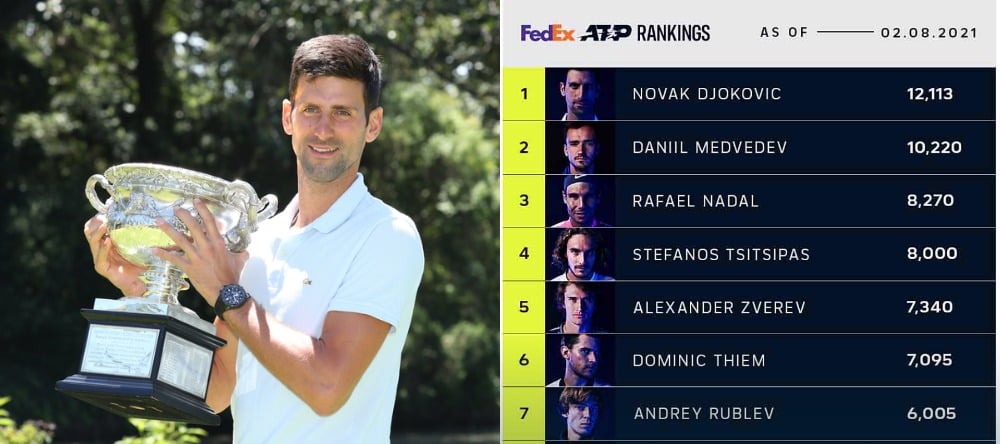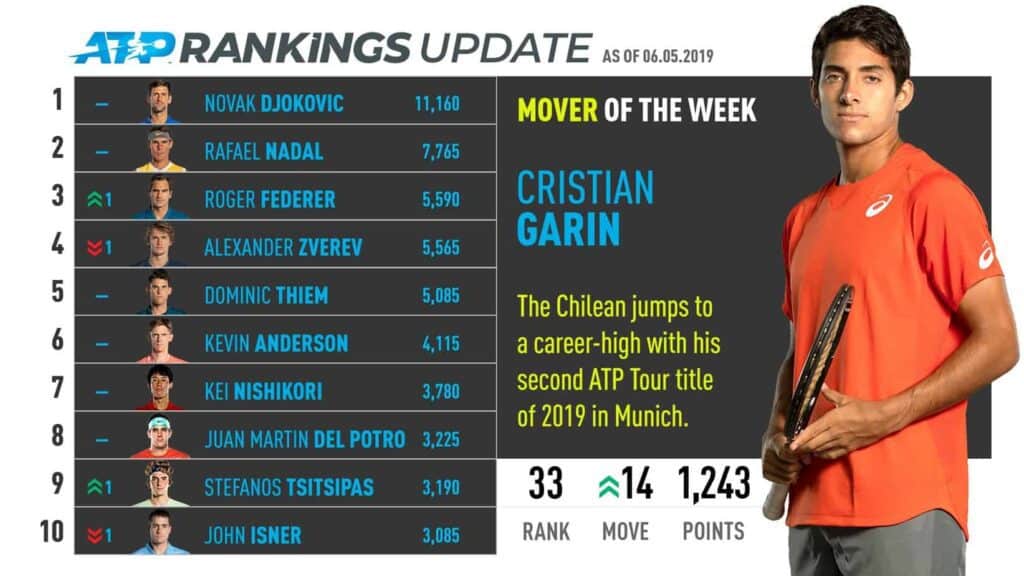How Tennis Rankings Work (Easy Guide)

Rankings are an interesting feature of professional tennis. A ranking system helps to determine the best players in the world.
You probably know that players can overtake each other after doing well in a tournament, but how exactly does it work?
The ATP & WTA Ranking System
In the ATP and WTA world rankings, players are ranked by their number of ranking points. The more points a player has the higher their ranking. A player’s ranking at any moment is based on the number of points they have earned from tournaments in the previous year.
A player wins a certain number of points at every tournament they enter, depending on how prestigious it is and how far they progress.
If a player performs better at an event than they did in the previous year, they gain points. If a player performs worse, they lose points. This change in points can influence their ranking.
Along with prize money and trophies, ranking points are a reward for players winning more matches at tournaments.
The ATP and WTA Tours have slightly different points systems, as do the Grand Slams (which are organized by the ITF).
We will discuss how points are awarded for each type of event, plus why rankings are important.
Why Do Rankings Matter?

1. Automatic Qualification
Having a high ranking is important because it gives players the right to automatically qualify for elite tournaments.
For example, players ranked inside the top 104 for ATP and WTA Tours do not have to qualify for Grand Slam main draws. Those ranked 105-232 have to win three qualifying matches or be awarded a wildcard to enter.
The same is true of other ATP and WTA events; a higher ranking potentially means direct qualification to Masters 1000s and other events. Not having to win qualifying matches is very helpful for saving energy later on in a tournament.
2. Higher Seeding
The higher a player’s ranking, the higher their seeding in a tournament. A player’s ranking does not always correspond to their seeding; if a player ranked 5 in the world enters a tournament and the 4thranked player does not, then the world number 5 will be the 4th seed for the tournament.
The top 32 male and female players who enter a Grand Slam are considered “seeded.” These 32 players are distributed evenly throughout the bracket. This means that they can avoid each other and, therefore, harder opponents until later in the tournament. This greatly improves their chances of winning early matches.
There is an added benefit of having a high seeding. The top 16 seeds (sometimes the top 32 seeds) at Masters 1000 tournaments automatically progress to the 2ndround. Hence, unlike the rest of the field, the highest-ranked players have one less match to worry about and can spend more time preparing.
3. Prestige
Finally, being ranked inside the top 8 on the ATP or WTA Tour allows players to participate in the prestigious year-end championships.
The ATP and WTA Finals are the most valuable titles in tennis behind the Grand Slams, offering a maximum of 1500 ranking points. Being a top-8 player (or doubles pairing) in the world is a requirement for automatic entry.
How Are Rankings Calculated?


On the ATP Tour, a player’s ranking points are the sum of their 18 or 19 best results over the last 52 weeks.
The following tournaments count towards a player’s total:
- The 4 Grand Slams (though strictly, these are ITF events)
- The 8 mandatory Masters 1000 tournaments (all except Monte Carlo)
- The World Tour Finals (if eligible)
- The best 6 results from Monte Carlo, ATP 500s, 250s, Challengers, Futures, and Davis Cup events
If a player does not qualify for the World Tour Finals, then only 18 tournaments contribute to their ranking. Monte Carlo is the only non-mandatory Masters 1000 event, so players can withdraw without affecting their ranking.
Players hold on to their ranking points for a whole year after a tournament concludes. A player’s points for a tournament renew when they participate again. If a player wins a tournament, they must defend their title the following year to avoid losing any points.
The ATP rankings update weekly every Monday. The player who collects the most points throughout the year is awarded the ATP year-end number 1 trophy.
The ranking system is very similar for the WTA except that 16 tournaments contribute to a player’s ranking in singles instead of 18 or 19.
Grand Slams
These are the 4 Grand Slam tournaments:
- Australian Open
- French Open
- Wimbledon
- US Open
The Grand Slams are the most sought-after titles in tennis, not only because of their prestige and prize money but also due to the ranking points they offer. In singles, winners of the men’s and women’s Grand Slam titles receive an enormous 2000 ranking points.
Players who exit in earlier rounds win a smaller number of points. Players who qualify for the main draw are also given some extra points. The points awarded for each round are slightly different for men’s and women’s draws.
Here is the exact breakdown:
| Result | Points Awarded (Men) | Points Awarded (Women) |
|---|---|---|
| Winner | 2000 | 2000 |
| Final | 1200 | 1300 |
| Semi-Final | 720 | 780 |
| Quarter-Final | 360 | 430 |
| Round 4 | 180 | 240 |
| Round 3 | 90 | 130 |
| Round 2 | 45 | 70 |
| Round 1 | 10 | 10 |
| Qualifying | 25 | 40 |
ATP Tour Events
Points are awarded in a similar fashion by almost all ATP events, though none are as rewarding as the majors. The World Tour Finals are the exception. There, players win 200 points for each round-robin victory. If they reach the final they earn an extra 400 points, while the winner gains an extra 900.
In the tables below, you will see a few optional numbers. That is because, depending on the draw size, some tournaments can have extra rounds, and consequently, the points distribution changes.
For instance, some Masters tournaments (such as Indian Wells) have 96 players in the main draw, so there are 7 rounds in total, starting from “round 1”. 32 seeded players skip the first round.
Conversely, other Masters events (like Madrid) have 56 players in the main draw, meaning there are only 6 rounds. In that case, the first round is “round 2” in the table. In those tournaments, only the top 16 seeds skip the first round.
ATP Masters 1000
| Result | Points |
|---|---|
| Winner | 1000 |
| Final | 600 |
| Semi-Final | 360 |
| Quarter-Final | 180 |
| Round 4 | 90 |
| Round 3 | 45 |
| Round 2 | 25 or 10 |
| Round 1 | 10 or N/A |
| Qualifying | 12 or 25 |
ATP 500

ATP 250

ATP Challenger Tour Events
At the level below the main professional ATP Tour, the Challenger Tour offers fewer points to participants. Much like the main tour events, Challenger events offer increasing numbers of points for progressing in the tournament.
The next level down from the Challenger Tour is the ITF Futures circuit. As of 2020, there are two types of Futures tournaments that players can enter. By winning, they earn either 10 or 20 ranking points.
Challenger competitions are similar to those on the main tour since their names correspond to the points awarded to the eventual winner.

Points Needed For Each Ranking Position (ATP)
Here’s how many points are currently needed on the ATP Tour for certain rankings:
| Ranking | Points Needed |
|---|---|
| Top 1000 | 12 |
| Top 500 | 70 |
| Top 250 | 250 |
| Top 100 | 760 |
| Top 50 | 1,160 |
| Top 25 | 1,950 |
| Top 10 | 3,350 |
| Top 5 | 5,150 |
| World No.1 | 11,540 |
Ranking Points for the World No.1 at the end of the year, 2013-2021.
| Year | Player | Ranking Points |
| 2021 | Novak Djokovic | 11,540 |
| 2020 | Novak Djokovic | 11,740 |
| 2019 | Rafael Nadal | 9,985 |
| 2018 | Novak Djokovic | 9045 |
| 2017 | Rafael Nadal | 10645 |
| 2016 | Andy Murray | 12685 |
| 2015 | Novak Djokovic | 16585 |
| 2014 | Novak Djokovic | 11360 |
| 2013 | Rafael Nadal | 13030 |
WTA Tour Events

The WTA Tour hosts a very similar array of tournaments to the ATP. The WTA Finals award 1500 to the winner and fewer points to everybody else, depending on round-robin wins.
There are 9 WTA 1000 events, 4 of which are mandatory and 5 of which are not. There are also equivalent WTA 500 and 250 events. Unlike in the ATP, these numbers do not necessarily refer to the champion’s points.
For example, the winner of a mandatory WTA 1000 tournament earns 1000 points, but a non-mandatory WTA 1000 only awards 900 points to the winner. WTA 500 events actually give winners 470 points, while winning a WTA 250 is worth 280 points.
As in the ATP, some tournaments have bigger draws than others, hence the number of rounds and points distribution vary slightly. Overall, the WTA ranking system is slightly more complicated than that of the ATP, but the tables below will hopefully clear up any doubts.
One final note: the WTA has no “Challenger Tour” equivalent, although there are a lot more ITF tournaments below WTA 250 level for female players to enter.
WTA 1000
Mandatory:

Non-Mandatory:

WTA 500

WTA 250

Points Needed For Each Ranking Position (WTA)
| Ranking | Points Needed |
|---|---|
| Top 1000 | 20 |
| Top 500 | 93 |
| Top 250 | 287 |
| Top 100 | 788 |
| Top 50 | 1,215 |
| Top 25 | 2,264 |
| Top 10 | 3,455 |
| Top 5 | 5,010 |
| World No.1 | 7,580 |
How Reliable Are The Rankings?

While the ranking system in general is pretty accurate, there are some exceptions. Here’s what you need to know.
Injured Players
While the ranking system is pretty accurate, there are some exceptions, like injured players. A player who doesn’t play for a couple of months due to an injury won’t get any ranking points, and will drop heavily in the rankings as the weeks go by.
An example of this is the greatest women’s tennis player of all time, Serena Williams. She was pregnant and hence, didn’t play for 9 months. Before her pregnancy, she was ranked as the world No.1, after her pregnancy, she dropped all the way to 453th in the world. Accurate? Not really.
However, some players can ask for a protected ranking that helps injured players to keep some ranking points.
Protected Rankings
With the ATP rankings only lasting a year, players can seriously tumble down the leaderboard as a result of an extended absence through injury.
Therefore, If a player gets injured in a minimum of six months, they can ask for a protected ranking, which is based on the player’s average ranking during the first three months of his or her injury. This means that the injured player can attend tournaments without showing up and gain ranking points for the first round of the tournament.
Allowances are made for players who miss mandatory tournaments through injury, like protected rankings. However, there are also penalties given to players who miss tournaments.
This is called “0-pointers”, which is exactly as the name suggests, assigns 0 points to one of the player-counted tournaments, basically removing one tournament from their ranking total.
Different Surfaces
Since the rankings are based on all surfaces, it isn’t always accurate. A player like Djokovic will be the favorite on hard court and grass against a player like Rafael Nadal, but on clay, Nadal would be the favorite.
Because of the way tennis is played with different surfaces, the rankings can be somewhat misleading. With most tournaments being played on hard courts, this is where the rankings are most accurate.
| Surface | How Accurate The Rankings Are |
|---|---|
| Hard Court | Very Accurate |
| Clay Court | Not Accurate |
| Grass | Not Accurate |
Summary
A high ranking is indicative of a consistent, world-class tennis player. Maintaining a high professional ranking is one of the great challenges in professional tennis because it requires non-stop work.
Once you have a high ranking, you have the privilege of entering the elite events without needing to qualify. This can greatly improve your chances of winning more trophies.
The points system is a little confusing, especially since the rankings update every week. However, one thing is obvious: rankings are a clear indication of which tennis players have performed best over the last year.






